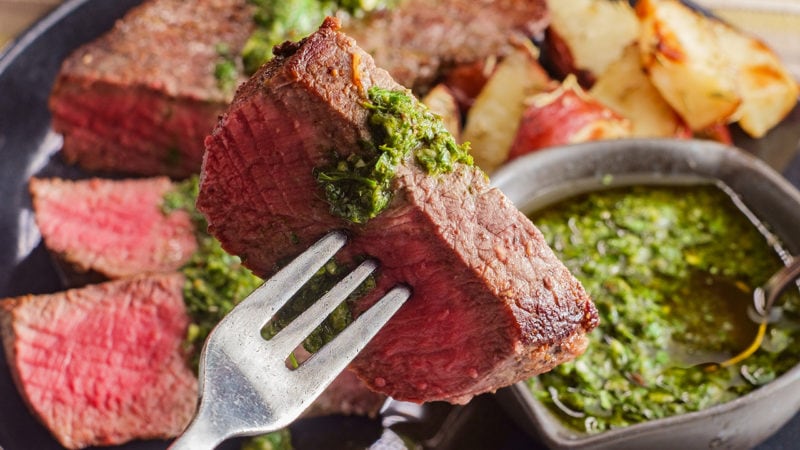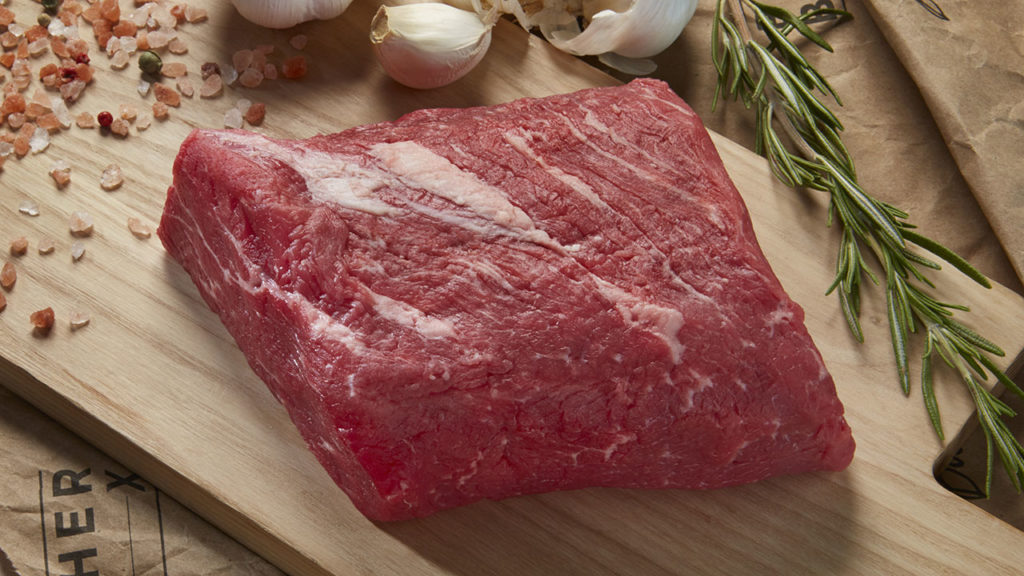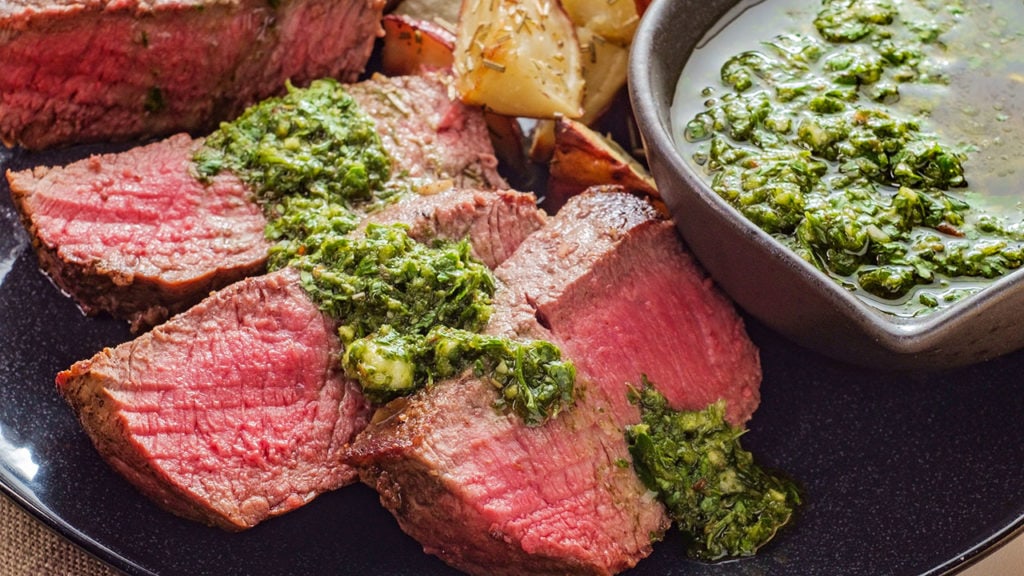Last Updated on October 1, 2020
You’ve probably enjoyed a fair bit of tri-tip roast, but do you know its history?
This California classic was popularized in the city of Santa Maria on California’s central coast. It’s since gone nationwide and is popular to grill and roast—although it can be hard to find on the East Coast.
The lean cut is mild, but flavor-packed and crazy juicy when prepared right. We’ll teach you how to grill and roast it to perfection, and supply you with recipes to get you started in your own kitchen.
What is Tri-Tip?
Tri-tip is a hefty roast. Cut from the bottom sirloin subprimal cut, the tri-tip is a triangular muscle with plenty of flavor. Un-trimmed, the roast weighs in at a healthy five pounds.
While other barbecue favorites originated in the American south, tri-tip got its start out west. The cut was popularized early on in California, where it was served in restaurants cooked in wine.
It became a specialty in the city of Santa Maria on California’s central coast, where to this day you’ll find it seasoned with salt, pepper, fresh garlic, and more, cooked over red oak wood to medium-rare.
It was once a rarity to find tri-tip at butchers nationwide, but today, it’s a popular cut for good reason. The cut is lean, but tender and rich in beefy flavor.
Cooked right, it produces an unbelievably juicy slice of roast. You can grill or roast it whole, or cut it into individual steaks.
How Do You Cook a Tri-Tip Roast?
- Grill: This is the fastest way to prepare a tri-tip roast, by far, and turns out rich and juicy every time. To get started, preheat your grill. When it’s roaring-hot, use tongs to wipe down the grates with an oil-soaked rag. You should aim to cook tri-tip to medium-rare, so place the tri-tip at a 45° angle across the hottest part of the grill. Cook for three minutes each side, rotating often. Move the steak to the indirect heat, then grill for 8 minutes per side, rotating halfway through. Remove the steak when it reaches an internal temperature of 130°F. Let it rest for eight minutes, then slice it thinly against the grain.
- Roast: You can roast a tri-tip low and slow, or you can aim for this more efficient method. First, preheat the oven to 425°F. Preheat a heavy skillet—like cast-iron or stainless steel—and add your favorite high-temperature cooking oil. Sear the tri-tip for two to three minutes a side, until you have a nice brown crust. Transfer the roast to a wire rack atop a sheet pan, then roast in the oven for 12 minutes. It’s done when it’s medium-rare and reaches an internal temperature of 120°F. This time, let it rest for 15 minutes, then slice it thinly against the grain.
Recipes To Get You Started:
Tri-Tip with Poblano Lime Chimichurri
Lean and juicy, a perfectly cooked tri-tip is the perfect vehicle for a bright and zesty chimichurri sauce. Best of all, this recipe looks impressive and cooks up in just 40 minutes flat.
You will have to prepare a bit the night before by salting the tri-tip roast and letting it sit uncovered in the fridge overnight. Let it come to room temperature for about 45 minutes before you cook it.
Preheat the oven to 425°F. Meanwhile, sear your tri-tip with some hot oil for about three minutes per side. Roast the tri-tip on a wire rack on a sheet pan for about 12 minutes, then let it rest for 15 minutes – just like we taught you above!
To make your zesty chimichurri, combine garlic, poblano pepper, cilantro, parsley, lime juice, olive oil, salt, and pepper.
Slow Roasted Tri-Tip with Confit Garlic and Smoked Chili Rub
Need a truly special roast? This slow-roasted tri-tip is rubbed down with smoked chili and spices, then served with confit garlic.
Light, mild, and juicy, the tri-tip soaks up all the flavors beautifully. Plus, you can make truly gourmet sandwiches with the leftovers, and use the remaining garlic oil on, well, everything.
To make the garlic confit, simmer olive oil and garlic together. Remove from heat and strain out the oil (save the oil for other uses – it’s delish), then add salt. Mash the garlic into paste.
Spread that garlicky goodness all over the tri-tip, then rub it down with a spice blend of ancho chili powder, Aleppo chili powder, chipotle powder, smoked paprika, smoked salt, kosher salt, and pepper.
The roast should take about an hour and a half, but check it every 20 minutes towards the end. Finish it off with a quick pan-searing in ghee, and enjoy.
Argentine Grilled Tri-Tip
Argentinians eat more beef per capita than any other country, and when they cook it, it’s often outdoors, infused with deep smoky flavor from wood.
This recipe is a testament to that, with quick-marinated meat cooked over direct heat.
Rub the tri-tip down with salt and pepper then marinate it in olive oil, garlic, rosemary, and lemon juice. From there, grill your steak until it reaches an internal temperature of 130°F. Let it rest for 10 minutes, then serve it with a fresh chimichurri.
Tri-Tip FAQs
Is there another name for tri-tip?
While tri-tip is the more common way to refer to this cut, its appearance in stores and butchers’ counters throughout the U.S. is pretty new. It’s also been called the “California cut” thanks to its regional origin, or a “triangle roast” or “triangle steak” because of its triangular shape.
What does tri-tip taste like?
This cut is deeply flavorful—and often a great, more inexpensive way to enjoy the same rich, beefy flavors found in more expensive cuts. Cooked well, this steak is tender, with just enough fat to give it depth. We recommend marinating it for even bolder flavor.
Tri-tip steak vs tri-tip roast – is there a difference?
Yes. The tri-tip roast is the complete roast, situated at the bottom of the sirloin. Tri-tip steaks are individual steaks cut from the roast. Un-trimmed, the roast weighs in at a healthy five pounds.
Is sirloin tip the same as tri-tip?
No. Despite its name, the sirloin tip is actually found on the round primal. It’s often made into roasts, individual steaks, or ground beef. The tri-tip is cut from the bottom sirloin subprimal cut.
Tri-tip vs. brisket – what’s the difference?
While both of these cuts make for excellent roasts, they’re pretty different. The tri-tip comes from the bottom sirloin, while the brisket comes from the front of the animal. Brisket requires a bit more time to break down and become tender, and there’s quite a sizable (pun intended) difference between the two. Tri-tip maxes out at about 5 pounds, untrimmed, while a brisket can be upwards of 12 pounds or more.





